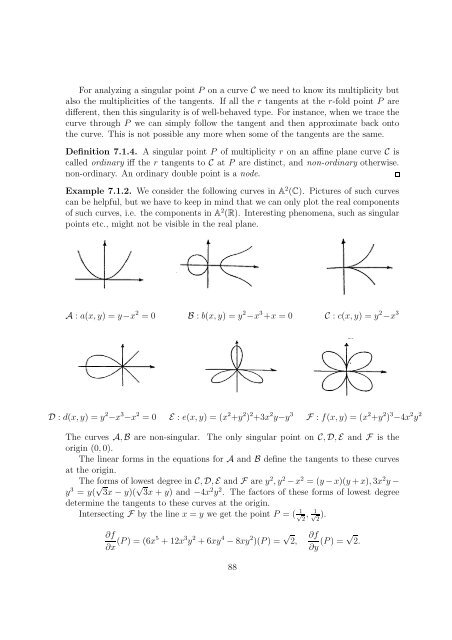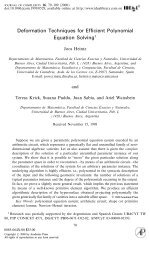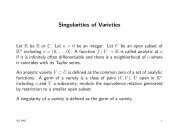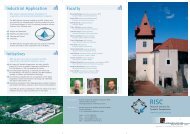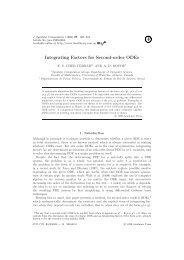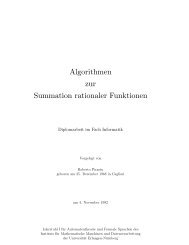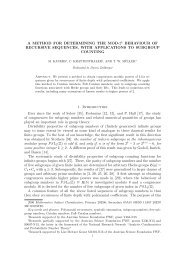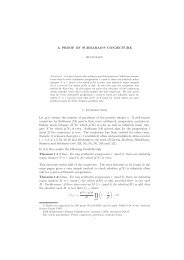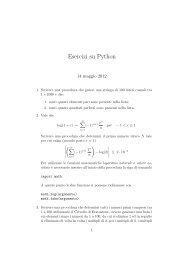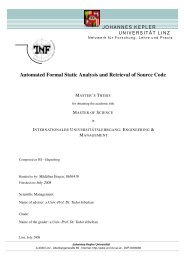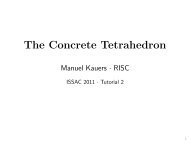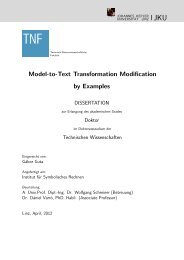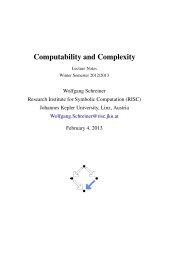Chapter 7 Local properties of plane algebraic curves - RISC
Chapter 7 Local properties of plane algebraic curves - RISC
Chapter 7 Local properties of plane algebraic curves - RISC
You also want an ePaper? Increase the reach of your titles
YUMPU automatically turns print PDFs into web optimized ePapers that Google loves.
For analyzing a singular point P on a curve C we need to know its multiplicity but<br />
also the multiplicities <strong>of</strong> the tangents. If all the r tangents at the r-fold point P are<br />
different, then this singularity is <strong>of</strong> well-behaved type. For instance, when we trace the<br />
curve through P we can simply follow the tangent and then approximate back onto<br />
the curve. This is not possible any more when some <strong>of</strong> the tangents are the same.<br />
Definition 7.1.4. A singular point P <strong>of</strong> multiplicity r on an affine <strong>plane</strong> curve C is<br />
called ordinary iff the r tangents to C at P are distinct, and non-ordinary otherwise.<br />
non-ordinary. An ordinary double point is a node.<br />
Example 7.1.2. We consider the following <strong>curves</strong> in A 2 (C). Pictures <strong>of</strong> such <strong>curves</strong><br />
can be helpful, but we have to keep in mind that we can only plot the real components<br />
<strong>of</strong> such <strong>curves</strong>, i.e. the components in A 2 (R). Interesting phenomena, such as singular<br />
points etc., might not be visible in the real <strong>plane</strong>.<br />
A : a(x, y) = y−x 2 = 0 B : b(x, y) = y 2 −x 3 +x = 0 C : c(x, y) = y 2 −x 3<br />
D : d(x, y) = y 2 −x 3 −x 2 = 0 E : e(x, y) = (x 2 +y 2 ) 2 +3x 2 y−y 3 F : f(x, y) = (x 2 +y 2 ) 3 −4x 2 y 2<br />
The <strong>curves</strong> A, B are non-singular. The only singular point on C, D, E and F is the<br />
origin (0, 0).<br />
The linear forms in the equations for A and B define the tangents to these <strong>curves</strong><br />
at the origin.<br />
The forms <strong>of</strong> lowest degree in C, D, E and F are y 2 , y 2 −x 2 = (y −x)(y +x), 3x 2 y −<br />
y 3 = y( √ 3x − y)( √ 3x + y) and −4x 2 y 2 . The factors <strong>of</strong> these forms <strong>of</strong> lowest degree<br />
determine the tangents to these <strong>curves</strong> at the origin.<br />
Intersecting F by the line x = y we get the point P = ( √ 1 1<br />
2<br />
, √2 ).<br />
∂f<br />
∂x (P) = (6x5 + 12x 3 y 2 + 6xy 4 − 8xy 2 )(P) = √ 2,<br />
∂f<br />
∂y (P) = √ 2.<br />
88


